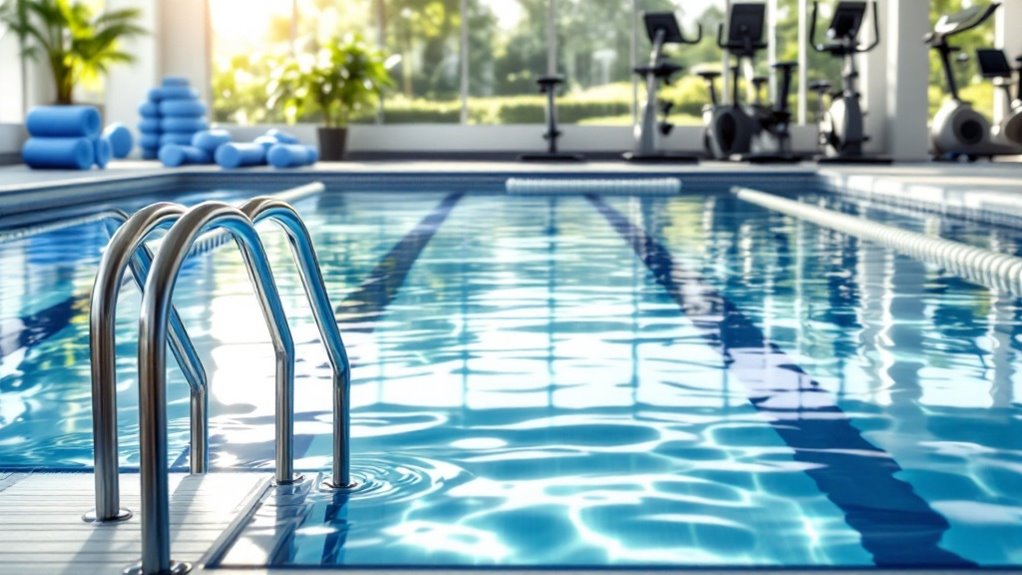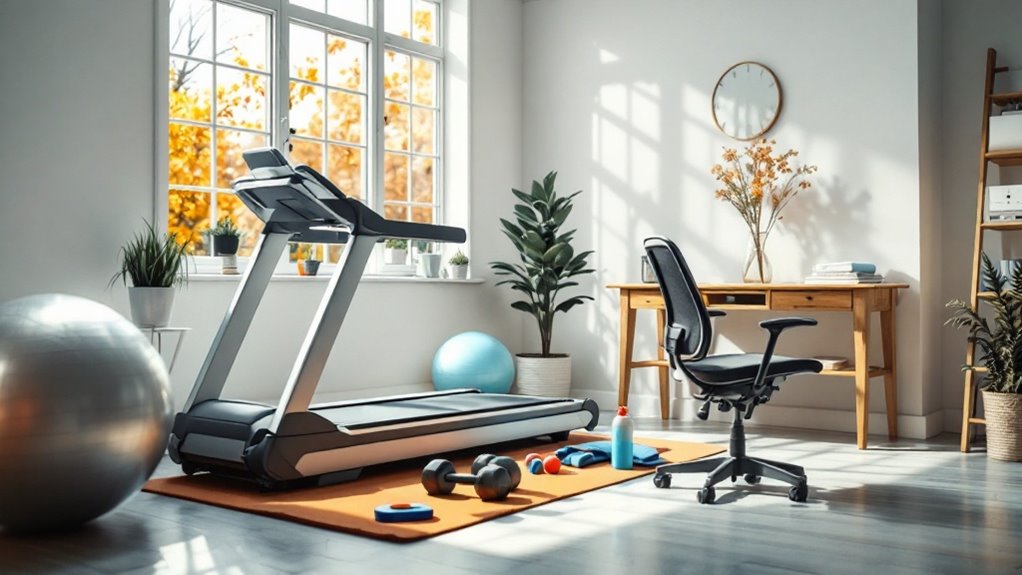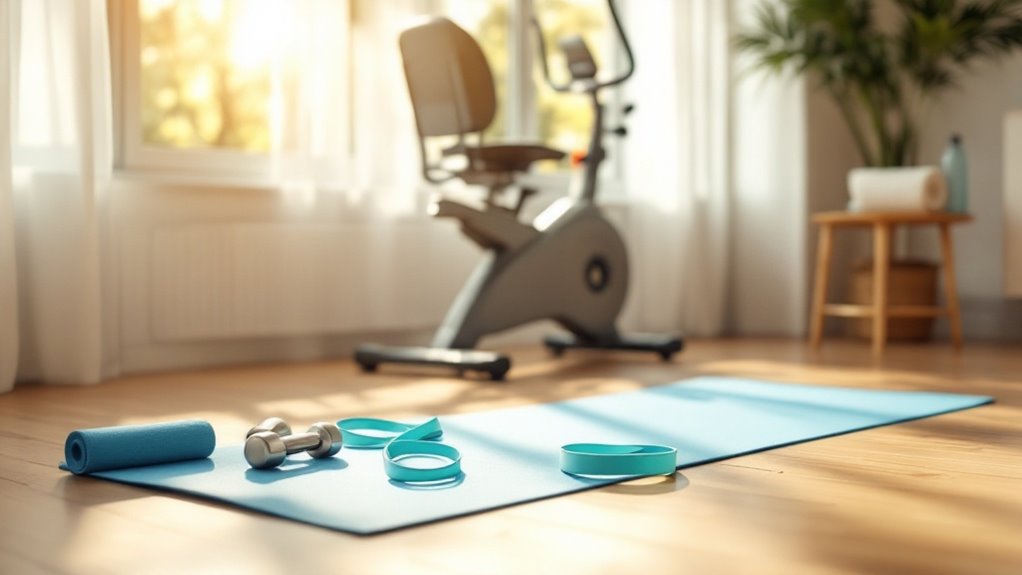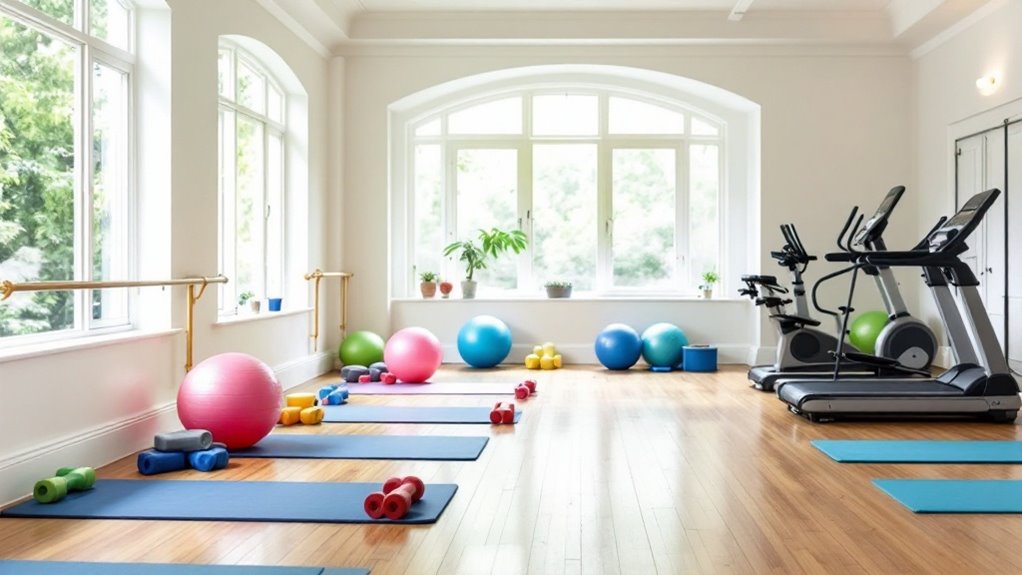Cardio Exercises for Seniors

Seniors can maintain cardiovascular fitness through low-impact exercises that protect joints while building endurance. Swimming provides full-body conditioning with water's natural resistance. Walking offers consistent benefits, especially on smooth surfaces. Stationary cycling strengthens legs without fall risks. Water aerobics combines social interaction with effective training. Elliptical machines deliver smooth movements for maximum cardiac gains. Following proper safety guidelines and individualizing routines reveals the full potential of senior fitness programs.
Key Takeaways
- Swimming and water aerobics provide effective low-impact cardio while protecting joints through water's natural buoyancy.
- Start with 10-15 minutes of walking or stationary cycling, gradually building up to 20-minute sessions three times weekly.
- Always consult a healthcare provider before starting exercise and stop immediately if experiencing dizziness or chest pain.
- Focus on proper form and safety by using supportive footwear, handrails, and exercising in well-lit, clutter-free spaces.
- Choose activities that match your fitness level and include warm-ups, steady-state cardio, and cool-downs in each session.
The Best Low-Impact Cardio Options for Older Adults

For seniors seeking to maintain an active lifestyle, low-impact cardio exercises offer the perfect balance of heart-healthy benefits without putting excessive stress on aging joints and muscles.
Swimming stands out as an excellent option, providing full-body involvement while the water's buoyancy protects joints.
Walking, especially on smooth surfaces or treadmills, delivers consistent cardiovascular benefits while being gentle on the body.
Stationary cycling eliminates fall risks while strengthening leg muscles and improving endurance.
Water aerobics combines social interaction with effective resistance training, and elliptical machines offer smooth, controlled movements that minimize impact stress while maximizing cardiovascular gains.
Regular participation in these activities can help manage type 2 diabetes and improve overall cardiovascular health when combined with proper warm-up routines.
Safety and Precautions for Senior Cardio Workouts

While low-impact cardio activities offer numerous benefits, proper safety measures need to guide every senior's workout routine.
Seniors should prioritize checking with their healthcare provider before starting any exercise program, especially those with chronic conditions or previous injuries.
Key safety protocols include proper warm-ups, maintaining good posture, staying hydrated, and exercising in a well-lit, clutter-free space.
Safety begins with the basics: warm up properly, watch your form, drink water, and choose a clear, bright workout space.
Seniors should monitor their breathing and heart rate, stopping immediately if they experience dizziness, chest pain, or unusual shortness of breath.
Wearing appropriate footwear with good support and using safety equipment like handrails when necessary can prevent accidents and guarantee a secure workout environment.
Starting with bodyweight exercises can help seniors build strength and stability while minimizing injury risks.
Building an Effective Cardio Routine at Any Age

Creating a sustainable cardio routine requires careful planning and progressive increases in intensity, regardless of one's starting fitness level. Seniors should begin with 10-15 minutes of low-impact activities like walking or stationary cycling, gradually building to 30-minute sessions.
The ideal routine includes three key components: a 5-minute warm-up, 20 minutes of steady-state cardio or interval training, and a 5-minute cool-down. Seniors should aim for 3-4 sessions weekly, allowing rest days between workouts for recovery.
Progress tracking helps maintain motivation and guarantees safe advancement. Small weekly improvements in duration or intensity lead to significant long-term fitness gains.
While experts recommend a full hour of daily exercise, even shorter workout sessions can deliver meaningful cardiovascular benefits for seniors.
Benefits of Regular Cardio Exercise for Seniors

Regular cardio exercise provides seniors with profound health benefits that extend far beyond basic fitness improvements. From improving cardiovascular health to boosting cognitive function, consistent aerobic activity helps maintain independence and quality of life in the golden years.
Studies show that seniors who participate in regular cardio exercise experience reduced risk of heart disease, improved blood pressure control, and better management of conditions like diabetes.
Regular cardio workouts help seniors lower their heart disease risk while better managing blood pressure and diabetes-related health concerns.
In addition, cardio workouts strengthen bones, improve balance, and maintain muscle mass – critical factors in preventing falls and maintaining mobility.
The mental benefits are equally significant, including reduced depression, sharper memory, and delayed onset of age-related cognitive decline.
The release of mood-enhancing endorphins during aerobic exercise helps seniors maintain emotional wellbeing and reduce stress levels.
Frequently Asked Questions
Can I Do Cardio Exercises if I Have Arthritis?
Exercising with arthritis is possible and beneficial when done correctly.
Low-impact cardio activities like swimming, water aerobics, stationary cycling, or elliptical machines reduce stress on joints while improving cardiovascular health.
Start slowly, listen to your body, and gradually increase intensity. Always consult a doctor before beginning any exercise program.
The key is selecting activities that don't aggravate joint pain while maintaining movement.
How Long Should I Wait After Eating Before Doing Cardio?
While some believe they can exercise right after eating, proper digestion timing is essential for peak performance.
As a general rule, individuals should wait 2-3 hours after a large meal before doing cardio exercise. For smaller snacks, 30 minutes to 1 hour is usually sufficient.
The body needs time to direct blood flow away from digestion and toward working muscles for effective exercise.
Should I Exercise Outdoors or Indoors During Different Weather Conditions?
Weather conditions greatly impact exercise location choices. For indoor workouts during extreme heat, rain, or cold, use gyms, home equipment, or bodyweight exercises.
When temperatures are moderate (45-75°F), outdoor exercise provides fresh air, vitamin D, and varied terrain benefits. Always check air quality indexes, UV ratings, and humidity levels before outdoor sessions.
During dawn/dusk hours, wear reflective gear and exercise in well-lit areas.
What Type of Shoes Are Best for Senior Cardio Workouts?
While some might think any old sneaker will do, selecting proper footwear for cardio workouts is mission-critical.
Look for shoes with superior cushioning, stability features, and a wide toe box. Top picks include Brooks Adrenaline GTS, New Balance 840v5, and ASICS Gel-Nimbus – all engineered with shock absorption and motion control.
Choose lightweight options with non-slip soles, breathable mesh uppers, and adequate arch support for maximum comfort and safety.
How Can I Track My Heart Rate Without Using Electronic Devices?
The manual pulse check can be performed by placing two fingers (never the thumb) on either the wrist or neck.
For the wrist, locate the radial artery below the thumb. For the neck, find the carotid artery beside the windpipe.
Count the beats for 15 seconds and multiply by 4, or count for 30 seconds and multiply by 2 to determine beats per minute.
Final Thoughts
What's stopping seniors from taking control of their heart health today? Regular cardiovascular exercise offers older adults a pathway to improved mobility, independence, and longevity. By choosing appropriate low-impact activities, following safety guidelines, and maintaining consistency, seniors can experience improved quality of life through cardio fitness. With proper dedication to a sustainable routine, older adults can continue enjoying an active lifestyle well into their golden years.


